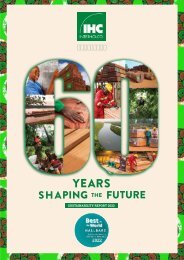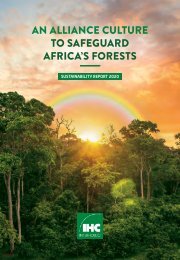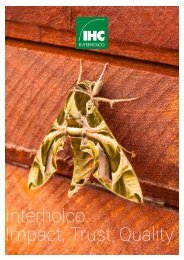Nomenclature Générale des Bois Tropicaux - 7ème édition
(english description below) Cette nomenclature est utilisée pour la mise à jour du 'Harmonized Code System' de l’Organisation Mondiale des Douanes. Dans la circulaire du 5 avril 2005, le Ministère de l’Economie, des Finances et de l’Industrie (France) reconnaît l’ATIBT comme « gardien du temple » de la nomenclature des bois tropicaux. La Commission Européenne mentionne la nomenclature de l’ATIBT comme document de référence pour la mise en œuvre du RBUE. Depuis 1954, l’ATIBT a établi et mis à jour une nomenclature des bois tropicaux faisant correspondre chaque espèce botanique avec un nom pilote reconnu internationalement. La détermination du nom pilote d’une essence est cruciale, car sa commercialisation dépend très largement de l’adoption de ce nom par le public. Le nom pilote assure la protection de l’appellation commerciale de l’essence et l’intégrité des propriétés qui lui sont attribuées, sans risque de confusion. The 1982 version of the general timber nomenclature has finally been updated as some of the 1,750 identified species, are no longer traded, while others, which were not previously included, are now on the market. The present revision has also integrated changes related to new taxonomy, in order to reflect the latest scientific developments. This Nomenclature has been used for the Harmonized Code System, updated by the World Customs Organization. The French Ministry of economy, finance and industry has given official recognition to ATIBT as the reference for the tropical timber nomenclature (NOR: PRMX0508285C of April 5th 2005). The European Commission refers to ATIBT nomenclature as a reference document for the implementation of the EUTR regulation. Since 1954, ATIBT has established and updated a nomenclature of tropical wood, linking each botanical species with an internationally recognized pilot name. A sigle wood species may have many common names; when trading across different countries, this may lead to confusion. Fixing the pilot name of a timber species is crucial, to protect the commercial denomination of the species and guarantee the veracity of the properties linked to that species, without confusion.
(english description below)
Cette nomenclature est utilisée pour la mise à jour du 'Harmonized Code System' de l’Organisation Mondiale des Douanes. Dans la circulaire du 5 avril 2005, le Ministère de l’Economie, des Finances et de l’Industrie (France) reconnaît l’ATIBT comme « gardien du temple » de la nomenclature des bois tropicaux. La Commission Européenne mentionne la nomenclature de l’ATIBT comme document de référence pour la mise en œuvre du RBUE.
Depuis 1954, l’ATIBT a établi et mis à jour une nomenclature des bois tropicaux faisant correspondre chaque espèce botanique avec un nom pilote reconnu internationalement. La détermination du nom pilote d’une essence est cruciale, car sa commercialisation dépend très largement de l’adoption de ce nom par le public. Le nom pilote assure la protection de l’appellation commerciale de l’essence et l’intégrité des propriétés qui lui sont attribuées, sans risque de confusion.
The 1982 version of the general timber nomenclature has finally been updated as some of the 1,750 identified species, are no longer traded, while others, which were not previously included, are now on the market. The present revision has also integrated changes related to new taxonomy, in order to reflect the latest scientific developments.
This Nomenclature has been used for the Harmonized Code System, updated by the World Customs Organization. The French Ministry of economy, finance and industry has given official recognition to ATIBT as the reference for the tropical timber nomenclature (NOR: PRMX0508285C of April 5th 2005). The European Commission refers to ATIBT nomenclature as a reference document for the implementation of the EUTR regulation.
Since 1954, ATIBT has established and updated a nomenclature of tropical wood, linking each botanical species with an internationally recognized pilot name. A sigle wood species may have many common names; when trading across different countries, this may lead to confusion. Fixing the pilot name of a timber species is crucial, to protect the commercial denomination of the species and guarantee the veracity of the properties linked to that species, without confusion.
You also want an ePaper? Increase the reach of your titles
YUMPU automatically turns print PDFs into web optimized ePapers that Google loves.
36 ///
Nomenclature générale des bois tropicaux 2016
NOM BOTANIQUE
BOTANICAL NAME
FAMILLE
FAMILY
CONTI-
NENT
Nothofagus obliqua Mirb. Nothofagaceae AM Pellin
NOM PILOTE
PILOT NAME
Nothofagus perryi Steenis Nothofagaceae AS New-Guinea Beech
Nothofagus procera Oerst. (cf. N.alpina) Nothofagaceae AM Rauli
Nothofagus pumilio Krasser Nothofagaceae AM Lenga
Ochanostachys amentacea Mast. Olacaceae AS Petaling
Ochroma lagopus Sw. (cf. O.pyramidale) Malvaceae (Bombacaceae) AM Balsa
Ochroma pyramidale Urb. Malvaceae (Bombacaceae) AM Balsa
Ocotea spp. (AM) Lauraceae AM Louro branco
Ocotea cymbarum Kunth Lauraceae AM Louro branco
Ocotea cymosa Palacky Lauraceae AF Varongy
Ocotea guianensis Aubl. Lauraceae AM Louro branco
Ocotea oblonga Mez Lauraceae AM Louro branco
Ocotea porosa Barroso Lauraceae AM Imbuia
Ocotea thouvenotii Kosterm. Lauraceae AF Varongy
Ocotea usambarensis Engl. Lauraceae AF Kikenzi
Ocotea wachenheimii Benoist Lauraceae AM Louro branco
Ocotea rodiei Mez (cf. Chlorocardium rodiei) Lauraceae AM Greenheart
Ocotea rubra Mez (cf. Sextonia rubra) Lauraceae AM Louro vermelho
Octomeles sumatrana Miq. Tetramelaceae AS Benuang
Oenocarpus bataua Mart. Arecaceae AM Patawa
Oldfieldia africana Benth. & Hook. Phyllanthaceae (Euphorbiaceae) AF Vésámbata
Olea capensis L. Oleaceae AF Musharagi
Olea capensis Baker (cf. O.hochstetteri) Oleaceae AF Musharagi
Olea welwitschii Gilg & G.Schellenb. Oleaceae AF Loliondo
Olmedioperebea sclerophylla Ducke (cf. Maquira
sclerophylla)
Moraceae AM Muiratinga
Ongokea gore Engl. Olacaceae AF Angueuk
Oreomunnea pterocarpa Oerst. * Juglandaceae AM Gavilán blanco
Ormosia spp. Leguminosae (Fabaceae) AM Tento
Ormosia coccinea Jack Leguminosae (Fabaceae) AM Tento
Ormosia coutinhoi Ducke Leguminosae (Fabaceae) AM Tento
Ormosia excelsa Benth. Leguminosae (Fabaceae) AM Tento
Ormosia paraensis Ducke Leguminosae (Fabaceae) AM Tento
Otoba spp. Myristicaceae AM Virola
Oxandra spp. Annonaceae AM Lancewood
Oxystigma oxyphyllum J. Léonard Leguminosae (Caesalpiniaceae) AF Tchitola
Pachira quinata W.S. Alverson Malvaceae (Bombacaceae) AM Saqui-Saqui
Pachyelasma tessmannii Harms Leguminosae (Caesalpiniaceae) AF Eyek
Pachylobus buettneri Engl. (cf. Dacryodes
buettneri)
Pachylobus deliciosus Pellegr. (cf. Dacryodes klaineana)
Burseraceae AM Ozigo
Burseraceae AF Adjouaba














